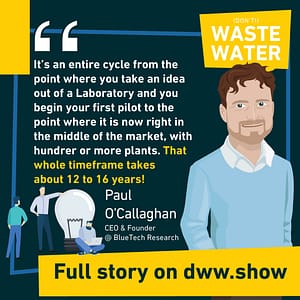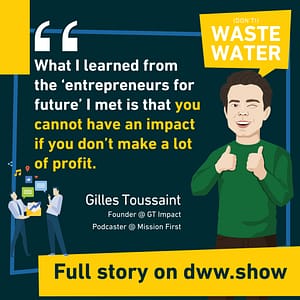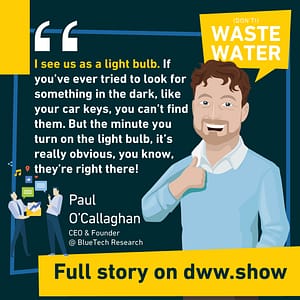🚀 Is your 2022 resolution to shake things up in the Water Industry and to become a Water Entrepreneur? Then start here ⬇️
🤔 Will you succeed in your Water Venture if you apply all of the insights shared here?
Well, if someone guarantees you something like that… run! 😅
BUT ☝️
In my humble opinion, you won’t succeed if you DON’T apply the advice shared here (see it as a necessary but not sufficient condition)
Let’s start!
Table of contents
- Expert Advice for Water Entrepreneurs
- The three pillars of Successful Water Entrepreneurship
- Is Hypergrowth possible in the Water Industry?
- Is the Scattered Water Industry an Opportunity for Entrepreneurs?
- Exiting to a Major, the Ideal Outcome?
- Into the Shark Tank: How SUEZ and VEOLIA fought it out over the years
Expert Advice for Water Entrepreneurs
Over the years, I had the chance to meet many successful water entrepreneurs.
I’ll not pretend, there’s an easy, universal formula that you shall apply and…

… you’ll build a water unicorn from scratch in your garage. No, let’s do a reality check: there’s still no water unicorn 😅
Yet, water entrepreneurship makes a lot of sense when you think of it that way:
We have an absolutely unique product: drinking water. It’s such a huge market that you can dream big! It’s not like you have a very niche thing that only a few people in the world would need. You have something that everybody needs every day! That’s a 7.5 billion people market today and in a few years about 10 billion people.
Jacob Bossaer – CEO & Founder of BOSAQ
The marketing of “Water” as a product is pretty straightforward
Some industries have to heavily invest in marketing to create a category or a market.
For the worst and the best, that’s not our case in the Water Sector, and that’s true in every geography:
You have multiple drivers for the African continent and they might not be immediate, but they are tangible. First, the urbanization: we’re starting from a very low level of water infrastructure. You have also industrialization, then you have more and more legislations and enforced regulations in terms of drinking water, water discharge limits, and so on. Then you also have the demographics with the young people, looking for jobs, and finally Africa is rising in terms of GDP and prosperity.
Walid Khoury – CEO & Founder of DESALYTICS
So, with all this demand, or to quote marketing guru Gary Halpert, this “starving crowd” every company on earth is dreaming of, why don’t we see Companies booming in every corner of the Water Industry? Paul O’Callaghan actually has an explanation.
Everyone was so enthusiastic about water. They all wanted to make a difference. There was inventeurs, entrepreneurs, investors, and yet many of those startup companies failed because they were chasing the wrong market, looking at the wrong opportunity and they weren’t having an impact for their work. And I thought: that’s a pity because these water challenges are huge!
Paul O’Callaghan – CEO & Founder of BLUETECH RESEARCH
Choosing the Right Business Opportunity
It’s a bit of a choice paradox issue. When billions of people lack access to water and sanitation, as we’ve seen in our deep dive on SDG6, and when dozens of technologies could solve the issue with their advantages and drawbacks, it’s hard to pick one and focus sufficiently to push it through.
The biggest or most difficult part is to say, okay, now we take a decision as a company to try to solve certain problems and not all of them.
Lea Im Obersteg – Head of Design Thinking
That may well be the key because we’re an Industry that commands commitment and dedication. Like any other, you think?
From the point where you take an idea out of a laboratory and you begin your first pilot to the point where it’s now right in the middle of the market, there’s a hundred or more plants out there, and the market’s going really rapidly; that whole timeframe that can take about 12 to 16 years. So if you’re a start up company today, In 2021, and you just did your first pilot, you would expect that maybe in 12 to 16 years time, this would be a mainstream market opportunity, that’s growing very, very well.
Paul O’Callaghan – CEO & Founder of BLUETECH RESEARCH

Let’s unpack this wisdom.
The Challenging Time to Market in Water Entrepreneurship
Assuming you have already developed enough to successfully pilot, you would have to commit and push for 12 to 16 years before starting to notice the exciting part of the hockey stick growth.
All of that, assuming you’ve got something in hand, that’s a smash material! I know that every single water entrepreneur firmly believes that what he’s working on is the best thing there was, there is, and there will ever be, but facts tell, this is very rarely true.

Sorry if I killed the mood. Now, if success can never be guaranteed, there are still some boxes you can check to place the most odds on your side.
The three pillars of Successful Water Entrepreneurship
I’ll let Gaetane Suzenet introduce her growth framework:
For successful innovation investment strategy, you need three things. You need entrepreneurs, you need scalability (which means market), and you need the tech. And for me, these are the three things which will make the water sector successful in the future!
Gaetane Suzenet – Co-Founder of the European Water Tech Accelerator
OK, so we have to look at entrepreneurs, markets, and tech.
1. Water Entrepreneurs
That sounds obvious, so let’s start here. What’s the typical profile a water entrepreneur should have?
Let’s assume you know the path you set yourself to follow, and that you’re aiming to solve a problem – which is a prerequisite. You now have to have the grit and you have to have the resilience. You have to have the passion because without the combination of those three, it doesn’t matter how big an idea you’re not going to be able to sustain it!
Meena Sankaran – CEO & Founder of KETOS
Let’s then add a layer of mindset to this profile:
A fool with a tool is still a fool! So if you’re not willing to open up to challenge the status quo, I can give you 10 or 20 tools and you will still come up with the answer that you want to hear.
Lea Im Obersteg – Head of Design Thinking

Be prepared to take risks, believe in yourself and convince people that what you’ve got and what you’ve done is the best.
Gaetane Suzenet – Co-Founder of the European Water Tech Accelerator
The next thing is to prevent falling victim to the shiny object symptom.
Pitfall to Avoid: Looking for Shortcuts
You know, like that trendy growth tactic or that segway to success that works in the books.
If you try to take shortcuts all the time, there is a moment where you can get lost. Yeah. At the end, you reach your destinations where after others who took the long road.
Gilles Toussaint – Founder of GT IMPACT
So what’s the solution?
What to do instead? Get your hands dirty!
Get out there, get your hands dirty! Install some pumps, do some lab tests. That’s crucial experience for your future engineering career!
Gilad Yogev
Ok, so we have the typical profile, the mindset, and the base approach of our water entrepreneurs. Let’s add a finishing layer: the ambition
Most entrepreneurs that are coming into the water sector are shy about how they carved the company’s projected growth, because investors are traditionally very risk averse in this industry
Meena Sankaran – CEO & Founder of KETOS

2. Serving the Right Market (in the Proper Way)
This ambition for growth Meena underlines doesn’t only offer us a smooth transition towards the second thrust of our framework, the market, but also underlines how important it is to see that growth as a Key Performance Indicator of something larger.
Impact as a Key Performance Indicator
The social side of entrepreneurship just means that you’re not just addressing a problem that has some commercial value, but it has to have a community impact or a social benefit. How can impact projects be created that have not just a commercial and a social impact, but also impacts my future growth? How can alternate business models be created for impacting migration around communities where in a lot of underdeveloped regions, that’s becoming a huge issue?
Meena Sankaran – CEO & Founder of KETOS
You can be in that water entrepreneurship game for many reasons!
You may for instance want to save the world and look at your growth as a proxy for impact.
I think I’m raised as a person that is against capitalism, but to beat capitalism, you get to become a part of it. How strange that.
Jacob Bossaer – CEO & Founder of BOSAQ

Building to last: Building Sustainably
But one thing’s for sure: economical success is integral to sustainability.
Any sustainable business, I believe cannot be truly sustainable. If it’s only reliant on incentives, grants, and subsidies.
Aaron Tartakovsky – CEO & Co-Founder of EPIC CLEANTEC
Profit is not a Swear Word!
… But rather a sign that you’re onto something big, in all the dimensions it involves.
But what I realized is that when you start a for-profit organization, lots of them want to have an impact. A lot of them care about the impacts first, but what I learned from all of them is that you cannot have an impact if you don’t make a lot of profit.
Gilles Toussaint – Founder of GT IMPACT

In a nutshell:
There’s nothing wrong with making money in the business. It’s it’s very important to be sustained.
Luke Butler – Director of Innovation at QATIUM
I’ll let Gaetane Suzenet conclude this second part on market and scalability with a straightforward statement:
It’s not the environment against the economy or society against the environment for me, it’s everything. So I was never afraid of saying that if you make money in the water industry, then it’s good.
Gaetane Suzenet – Co-Founder of the European Water Tech Accelerator

3. Developing and Promoting the right Technology
Now, let’s look at the third thrust: the technology we will push and develop as water entrepreneurs, that will lead to impact and will make a dent in this very special Water Industry.
Is that part easy as pie? Certainly not! (It wouldn’t be fun otherwise, right? 😉)
Technology development is a race. It’s a race against funding running out. Against patents expiring, against competition entering the market. And it’s a race against commoditization! The technology race needs, innovators, entrepreneurs, typically who build companies around being able to be the only people or a few people who can offer that technology. And eventually it becomes more and more mainstream. So when it gets to the point, the knowledge is so widely spread and the art is well-known within the engineering community; at that point, the race is over. That’s the reason why it takes time to get into the engineering books.
Paul O’Callaghan – CEO & Founder of BLUETECH RESEARCH

Technology Development requires Money and Guts
But if technology development is a race, you’ll need to be ready to take some risks and to push your chips on the table again and again!
In three years and a half, we’ve been almost three times bankrupt. Not because we’re doing bad, but just when you investing hugely in one, it’s coming, that’s what you have to do as well. And that’s of course, to grow as fast as possible because for us growth is equals impact.
Jacob Bossaer – CEO & Founder of BOSAQ

You can have two approaches there: first, build what Paul O’Callaghan calls a value-driven innovation in his thesis on the Dynamics of Water Innovation. The idea here is to bring something that betters the state of the art and adds value.
Now, as counter-intuitive as it sounds, that’s not the safest bet for success. In a conservative industry with high stakes, it may be hard to convince someone to move from what he knows is working for sure to a new technology with “only” a 20% saving.
Is your Tech Value-Driven or Crisis-Driven?
Hence, the second approach: identifying a crisis or a hard-edge and offering a solution to it. This has better chances of taking of because regulation shall have your back and enforce the adoption of your tech. But as Paul warns all of us, it may also be a bit more dangerous.
It’s a bit more risky because you need to make sure that there is a crisis, and that there is regulation. And we’ve seen people who think there’s a crisis that end up waiting and waiting and waiting. And then the crisis never comes. People who think that sludge won’t be applied to land or that ballast water treatment would be regulated quickly. And of course it was delayed! That’s why those things move quicker. But you have to be certain that the conditions are right.
Paul O’Callaghan – CEO & Founder of BLUETECH RESEARCH

The example Paul takes here is very clear: if you had bet on the “Ballast Water Crisis” with your tech when the Hype Curve was at its highest, ten years ago, you probably ran out of cash long before it became mainstream – as this still hasn’t happened in 2021.
This is true nowadays, for instance, with microplastics, endocrine disruptors, or PFAS removal. But on the flip side, that’s also what brought membrane technologies in the middle of the market in the 90s, when cryptosporidium threatened the intestinal transit of millions of people.
Is there a magical trick?
So what’s the martingale here? Well easy as pie, right: just be innovative! Is it really that simple?
It’s not a magic pill that you can just swallow. And all of a sudden, everybody becomes very innovative and we have this 30 million opportunities popping up!
Lea Im Obersteg – Head of Design Thinking
An innovative approach for your tech doesn’t have to be this Eureka moment where you drop out of your bath naked, draft your future technology that’s of course crisis-driven, and open your bank account to ensure having enough space to house your future millions.
Yet there’s a much more powerful bullet-proof approach:
It is impossible to copy solutions, but the ideas and the principles and some of the technologies can, and should be adapted from one place to another!
Ravid Levy
A good bet here may well be to look at our cousin industries and to try to replicate what works best there. The example I’ve shared a lot is energy and its microgrids that could be replicated in distributed treatments in our Water world.
What’s the Path Forward?
Well, maybe, as Walid Khoury suggests, leverage the agility you have as a water entrepreneur, an asset that’s often long gone for mainstream players.
Multinationals are more prone to go to Asia compared to Africa because they see it as easier to do business. So the African market is kind of left behind because it’s too fragmented. It’s too complicated for multinationals.
Walid Khoury – CEO & Founder of DESALYTICS
You also need to find your people inside your starving crowd. The core group inside that ocean, that is eager to adopt your technology faster, and promote it to fuel your growth. In a nutshell, your early adopters. How to find them?
The early adopter is a person. It’s not a utility, it’s not a corporation. It’s an individual within that group.
Paul O’Callaghan – CEO & Founder of BLUETECH RESEARCH
Is Sky the Limit?
Well, I’ll let Alexander Loucopoulos manage your expectations.
I’m generally incredibly optimistic about water as a business opportunity, but at the same time, I’m not delusional to think that you’re going to have a billion dollar technology company coming out in the next two years in the water space.
Alexander Loucopoulos – Partner at Sciens Capital Management and Sciens Water
Now, becoming a unicorn isn’t the only possible outcome.
The multiple faces of Success
Water entrepreneurs’ agility can also become an asset in a major’s game to do external R&D or external growth. Simply put: align for an exit. Or become a knife in a street fight, as Wayne Byrne colorfully describes it:
The majors do acknowledge that they will be cannibalized by businesses like ours. And the day they want to fight it off, we would be a knife. Honestly, you always want to be a knife in this street fight when the commercial Titans are fighting it out!
Wayne Byrne – CEO of TYPHON TREATMENT SYSTEMS
Why would you want to follow that advice? Maybe because successful entrepreneurs usually experience an exit once in their career. Some of them, twice. And some UFOs like Wayne, four times – and counting.
Is Hypergrowth possible in the Water Industry?
In their paper, investigating how Sustainable Investing can save the world, Florian Heeb and Julian Kölbel show how impact investors shall:
➡️ Increase a company’s Environmental, Social, and Governance (ESG) factors
➡️ Increase the company’s size, provided that its ESG practices are already above average.
Let’s imagine that a Water Tech Startup enters the market with that said above-average impact.
Helping it to grow, helps the industry’s average along – it’s simple maths. 🤓
… and doing it faster shall promptly create overall impact.
Hence, Hypergrowth may be the way to Sustainability!
But the Water Sector doesn’t (yet) have a bold example of a successful “hypergrown” company.
Sure there are impressive paths. But – sorry to insist – it never featured a water unicorn. 🦄
➡️ So, is it only a matter of time? Or is it firmly against the sector’s DNA to grow such a shiny “animal”?
That’s what I tried to answer in this deep dive, leveraging valuable insights shared by Gaetane Suzenet, Megan Casey Glover, and Paul O’Callaghan.
Is the Scattered Water Industry an Opportunity for Entrepreneurs?
The top 50 just evolved, with Veolia buying a good chunk of SUEZ.
But, what really caught the attention of most water professionals, in Global Water Intelligence’s latest release of this top 50, is the total of their revenues.
If you sum it, you get about 130 Billion Dollars.
Now, collide this news with ByteDance’s latest valuation. TikTok’s mother company is currently valued at 250 Billion Dollars, so roughly double of the 50 largest water companies, ALL TOGETHER.
But wait, is an app where people dance really worth twice an entire sector, dealing with the key ingredient of life on earth? We verified it, check it out here (spoiler: no 😉)
Exiting to a Major, the Ideal Outcome?
Both VEOLIA and SUEZ did not grow to the Water World’s top 2 spots by relying solely on their internal abilities.
It involved Mergers and Acquisitions (abbreviated M&A).
But if some of those still shape the giants we now know, some others turned out to be major failures.
In this deep dive, we look at the 3 most prominent ones of the last 20 years!
Into the Shark Tank: How SUEZ and VEOLIA fought it out over the years
What’s the endgame as a Water Entrepreneur? You could be selling your company to a major (so you’re concerned about their path). Or you could BECOME one of these majors!
So, it’s quite interesting to look at the bigger picture, and analyze the behavior of the big beasts.
After years of tries and rumors, 2020 saw a decisive move of VEOLIA on SUEZ, that led to the merger (and the split) of the two entities. You can look at it with an amused eye and some popcorn, but the truth is, it necessarily has an impact on the Water Industry when the world’s n°1 absorbs a consequent portion of the world’s n°2!
One of these impacts, may well be a huge opportunity for water entrepreneurs: won’t a giant in the making be suddenly much less agile? What happens when customers have fewer options available?
But that story is for sure too long to be dealt with in just a couple of lines, so have a look here if you’d like to learn more – I prepared you a dedicated deep dive!

